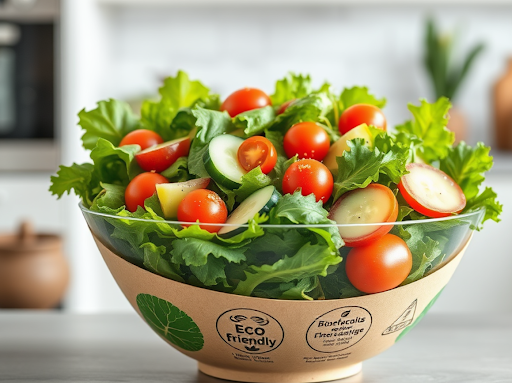Want to make your salad shop stand out while doing something good for the planet? Nowadays, packaging isn’t just about keeping your food fresh—it’s a big part of how customers see your brand. For salad shops, especially, where health and freshness are already selling points, sustainable packaging can take your business from average to awesome. And with more people ordering takeout than ever, now’s the time to upgrade what your salads are served in.
Why Packaging Matters More Than You Think?
Your packaging is the first thing customers notice when they get their delivery. Is it wasteful plastic? Or does it say, “We care about the environment—and you”?
A 2022 survey found that 67% of Gen Z consumers are willing to pay more for eco-friendly packaging. That’s a huge market segment, and they’re voting with their wallets. If your shop is still using traditional plastic salad bowls, you’re not just missing a sustainability mark—you could be losing customers, too.
Also, local and state policies are tightening up. From New York to California, bans on single-use plastics are growing fast. Sooner or later, sticking to plastic will cost you more than just brand reputation—it could come with actual fines.
Greener Solutions: What Are Your Options?
There’s no one-size-fits-all answer, but here are some smart alternatives to traditional plastic salad bowls:
1. Compostable Bowls (e.g., Sugarcane Fiber)
These are made from bagasse, a byproduct of sugarcane processing. They’re fully compostable in 90 days, sturdy, and heat-resistant—perfect for warm quinoa bowls or chilled Caesar salads. Some suppliers offer leak-proof versions that don’t sacrifice performance.
2. Recyclable Paper Bowls
These bowls, when paired with a thin PLA lining, can keep food fresh and still go in the recycling bin (depending on local rules). They’re more familiar to customers and cost-effective, especially for cold salads.
3. Reusable Silicone Bowls
If your customers are mostly regulars or you offer meal subscriptions, reusable silicone bowls can cut waste long-term. They’re dishwasher-safe and come in sleek, modern designs—but the upfront cost may be higher.
4. Salad Packaging Innovation
For those looking to go the extra mile:
- Edible ink labels: Print your branding or eco-message with ink that’s safe and biodegradable.
- Seaweed-based film: A plastic-free wrap that’s compostable and doesn’t sacrifice quality.
Proper Design Make Sustainability Look Good
Going green doesn’t mean going boring. Here’s how to design packaging that reflects your fresh brand identity.
Use Nature-Inspired Colors
Think browns, greens, and neutral tones. These shades tell your customers, “This food is fresh, wholesome, and good for the earth.” A minimalist kraft paper box with a clear window can look premium without being flashy.
Keep It Clean and Simple
No one likes clutter. Use clean fonts and leave space for your branding to breathe. Less really is more—especially when your food speaks for itself.
Add Eco Messaging
A short line like “This bowl feeds you, not landfills” or “100% compostable in 90 days” printed right on the lid can go a long way. It shows transparency, builds trust, and reinforces your green values without saying a word.
How to Make the Switch Without Breaking the Bank?
We get it—switching packaging isn’t always easy, especially for small salad shops.
Many U.S. packaging suppliers are focused on high-volume clients. That means high minimum order quantities, expensive custom design, and the big one: no space to store it all. For most small restaurants, that’s just not realistic.
But here’s a smarter way to start:
1. Start Small
You don’t need to change everything at once. Try switching the packaging for your top-selling salad first. Monitor customer feedback, delivery performance, and cost differences.
2. Negotiate with Suppliers
Some suppliers like Fusenpack are now offering more flexible solutions for small restaurants. That means smaller minimum orders, simpler design processes, and quicker turnaround times.
3. Skip the Custom (For Now)
If custom printing is too expensive or complicated, go with deli paper or pre-branded eco-friendly packaging that still looks great. You can always add a sticker or stamp for your logo later.
4. Plan for Storage
Consider sharing storage space with nearby restaurants or joining a co-op buying group. Bulk buying doesn’t have to mean bulk storing—teamwork can lower your per-unit cost and free up kitchen space.
Ready to Make a Change?
Your salad shop is already part of a healthy lifestyle movement. Why not take it one step further? Sustainable packaging isn’t just good for the planet—it’s good for business. It shows customers that your values align with theirs. It helps you stay ahead of changing laws. And most importantly, it sets your brand apart in a crowded food delivery world.

